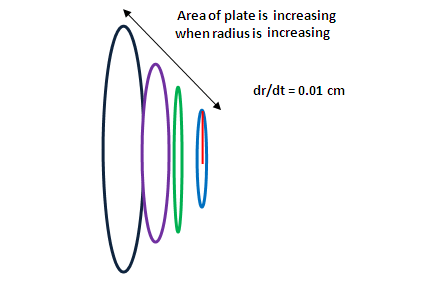RATE OF CHANGE WORD PROBLEMS IN CALCULUS
The derivative can also be used to determine the rate of change of one variable with respect to another. A few examples are population growth rates, production rates, water flow rates, velocity, and acceleration.
A common use of rate of change is to describe the motion of an object moving in a straight line. In such problems, it is customary to use either a horizontal or a vertical line with a designated origin to represent the line of motion.
On such lines, movements in the forward direction considered to be in the positive direction and movements in the backward direction is considered to be in the negative direction.
Problem 1 :
The radius of a circular plate is increasing in
length at 0.01 cm per second. What is the rate at which the area is increasing
when the radius is 13 cm?

Solution :
Let A and r be the area and the radius.
Rate of change = 0.01 cm
Area of circular plate A = πr2
Differentiate with respect to r
dA/dt = π2r(dr/dt)
here r = 13 cm and dr/dt = 0.01 cm
dA/dt = π2r(dr/dt)
dA/dt = π2(13) (0.01)
dA/dt = π(26)(0.01)
dA/dt = π(0.26)
dA/dt = 0.26π cm2/sec
Problem 2 :
A square plate is expanding uniformly each side is increasing at the constant rate of 1.5 cm/min. Find the rate at which the area is increasing when the side is 9 cm.
Solution :
Let a be the side of the square and A be the area of the square.
Here the side length is increasing with respect to time.
da/dt = 1.5 cm/min
Now we need to find the rate at which the area is increasing when the side is 9 cm.
That is,
We need to determine dA/dt when a = 9 cm.
Area of square = a2
A = a2
differentiate with respect to t
dA/dt = 2a(da/dt)
dA/dt = 2(9)(1.5)
dA/dt = 18(1.5)
dA/dt = 27 cm2/min
Problem 3 :
A stone thrown into still water causes a series of concentric ripples. If the radius of outer ripple is increasing at the rate of 5 cm/sec,how fast is the area of the distributed water increasing when the outer most ripple has the radius of 12 cm/sec.
Solution :
Let A be the area and r be the radius.
Here the radius is increasing with respect to time.
Now we need to find dA/dt when radius = 12 cm/sec
dr/dt = 5 cm/sec
Area of circle = πr2
A = πr2
dA/dt = 2πr(dr/dt)
dA/dt = 2π(12)(5)
dA/dt = 24π(5)
dA/dt = 120π cm2/sec
Problem 4 :
The radius of a spherical balloon is increasing at the rate of 4 cm/sec. Find the rate of increases of the volume and surface area when the radius is 10 cm.
Solution :
Let V be the volume of spherical balloon and S be the surface area.
Here, we need to find dV/dt and dS/dt.
dr/dt = 4 cm/sec and r = 10 cm.
Volume of the spherical balloon (V) = (4/3)πr3.
Differentiate with respect to t.
dV/dt = (4/3)π3r2(dr/dt)
dV/dt = (4/3)π3(10)2(4)
dV/dt = 16π(100)
dV/dt = 1600π cm3/sec
Surface area of the spherical balloon S = 4πr2.
differentiate with respect to t.
dS/dt = 4π2r(dr/dt)
dS/dt = 8πr(dr/dt)
dS/dt = 8π(10)(4)
dS/dt = 80π(4)
dS/dt = 320πcm2/sec
Problem 5 :
A balloon which remains spherical is being inflated by pumping in 90 cm3/sec. Find the rate at which the surface area of the balloon is increasing when the radius is 20 cm.
Solution :
Let V be the area and r be the radius of the balloon.
dV/dt = 90 cm3/sec.
V = (4/3)πr3
dV/dt = (4/3)π3r2(dr/dt)
90 = 4π(20)2(dr/dt)
90 = 4π(400)(dr/dt)
90 = 1600π(dr/dt)
90/(1600π) = (dr/dt)
dr/dt = 9/(160π)
Surface area of the spherical balloon (S) = 4πr2
dS/dt = 4π(2r)dr/dt
dS/dt = 4π(2 x 20)(9/160π)
dS/dt = 160π(9/160π)
dS/dt = 9 cm2/sec
Kindly mail your feedback to v4formath@gmail.com
We always appreciate your feedback.
©All rights reserved. onlinemath4all.com
Recent Articles
-
Multi Step Algebra Word Problems
Apr 23, 24 09:10 PM
Multi Step Algebra Word Problems -
Solving Multi Step Word Problems Worksheet
Apr 23, 24 12:32 PM
Solving Multi Step Word Problems Worksheet -
Solving Multi Step Word Problems
Apr 23, 24 12:07 PM
Solving Multi Step Word Problems
